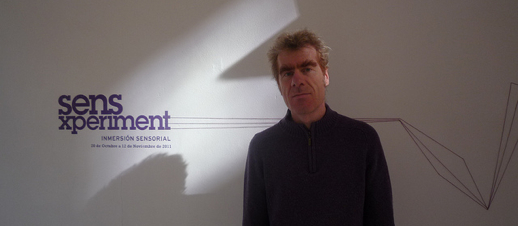[Breve texto escrito sobre le trabajo de Pascal Batus para el festival Sensxperiment 2011]
“El hechicero comienza a sacudir una calabaza llena de gravilla […] para tratar de ahuyentar a los mandatarios de la Muerte. Hay un silencio ritual, preparador del ensalmo, que lleva la expectación de los que esperan a su colmo” Alejo Carpentier. Los Pasos Perdidos
La confianza en el poder transformador del sonido, ya sea en su forma más pura o en su formalización musical, es una constante a lo largo de historia. La atribuida capacidad para representar aquello que difícilmente podría ser representado de algún otro modo, pero, sobre todo para conmutar y moldear nuestras reacciones, lo han convertido en un interesante “objeto” de estudio al tiempo que escurridizo.
La división tripartita (música mundana, música humana y música universal), que el pensamiento griego clásico establecía del universo en función del origen de los sonidos, crea una cosmología sonora que permanece en los discursos filosóficos hasta el siglo XVII y sobrevivirá latente en ciertos círculos de pensamiento místico hasta el siglo XX.
Textos como Harmonices Mundi (1619) de Johannes Kepler, el Traité de l´Harmonie Universelle (1627) de Marin Merssenne o Musurgia Universalis (1650) de Athanasius Kircher perpetúan esta idea pitagórica de una armonía de las esferas que los planetas generan al moverse. Pero más allá del oximorón que supone la existencia de una música silenciosa, estos teóricos demostrarán especial interés por una suerte de fenomenología del sonido intentando desentrañar el origen de su capacidad para alterarnos.
Retomando algunos de los presupuestos clásicos del ethos/pathos griego, filosofía y ciencia se alían en el siglo XVII para vincular experiencia sensorial y emoción con la meta de encontrar una teoría útil y universal que explique las “pasiones del alma” como propone Descartes, quien se someterá a este dualismo cuando reconoce en las primeras líneas del Musicae Compendium (1618) que la finalidad de la música es «deleitar y provocar en nosotros diversas pasiones», proponiendo un ejercicio que reconcilia razón y emoción a través de la teoría de los afectos desarrollada años más tarde.
Si bien los presupuestos eminentemente racionales de esta ciencia de las emociones ocupará un lugar importante durante el XVII y XVIII, poco a poco se irá desintegrando a medida que entraban en crisis los ideales ilustrados. Pero la confianza en el poder del sonido para generar reacciones inalcanzables por otros medios se ha mantenido, al menos como un recurso poético, invariable en el ámbito de la experiencia estética.
Esta es la convicción sobre la que Pascal Battus desarrolla su trabajo en el que los sonidos son tan importantes como la situación que los envuelve. No se trata de un concierto, sino de una ocupación del espacio invadiendo los límites de nuestra proxémica cotidiana. Battus busca engrandecer los sonidos y sus efectos aprovechando la intimidad, la posición del uno contra uno, así como la sensación de desprotección que sentimos cuando tenemos los ojos vendados.
Propicia un ritual de confianza, de fe, que utilizan otros artistas sonoros como Quiet American en su Desert Sun o Francisco López en sus conciertos. Pero también un ritual de aprendizaje acusmático que recibe su nombre de las prácticas pedagógicas pitagóricas.
Battus sobredimensiona los sonidos no llenando el espacio con decibelios, si no por la proximidad, confiriéndole a sus interpretaciones un carácter táctil y penetrante, de ahí el apelativo de masajes sonoros.
Si bien a veces este contacto físico se produce directamente de piel a piel, como en los “masajes sonoros tocando” (touching sound massage) en los que aprovecha la transmisión osea del cráneo, la mayoría de sus extrategias pasan por mantener cierta distancia ya sea frotando, golpeando, agitando… diferentes utensilios (air sound massage, deep air massage y massage vocal) cuyas vibraciones acarician el oído, pero, sobre todo, estimulan la escucha.
En otras ocasiones se sirve de utensilios como unos cascos aislantes (helm massage) o de objetos resonantes (silent massage y solidien massage in space) o modifica el medio (massage aquatique) para, en lugar de producir nuevas fuentes sonoras modificar las que ya percibimos. Su repertorio se completa con variaciones más complejas como las realizas por dos personas (2 par 2 y Comput’off).
Basados en la improvisación y en la exploración de diferentes parámetros de nuestro campo audible (distancia, simetría/asimetría, estereofonía -horizontalidad- y verticalidad) la finalidad última del trabajo de Pacal Battus es “despertar en tu interior la sensación de una nueva vida sonora”.
//
“The sorcerer begins to shake a pumpkin full of gravel […] to try to keep away the leaders of Death. There is a ritual silence, preparing the spell, that leads the expectation of whom wait for its completion.” Alejo Carpentier, The Lost Steps
Confidence in the transformative power of sound, either in its pure form or in its formalization as music, is constant throughout history. The supposed ability of sound to represent what could hardly be represented otherwise, and to commute and shape our reactions, have transformed sound into an interesting and elusive ‘object.’
The classical Greek philosophers established a tripartite division (mundane music, human music and universal music) depending on the origin of sounds, creating a sonic cosmology that remained on philosophical discourse until the 17th century, and even until the 20th century in certain mystical thinking doctrines.
Texts like Harmonices Mundi (1619) by Johannes Kepler, Traité de l’Harmonie Universelle (1627) by Marin Merssenne and Musurgia Universalis (1650) by Athanasius Kircher perpetuated the Pythagorean idea of a harmony of the spheres generated by the movement of the planets. Although this concept is an oxymoron, because it assumes the existence of a silent music, all these thinkers were interested in the phenomenology of sound and tried to understand why sound affects us.
During the 17th century, some thinkers reintroduced the classical assumptions of the Greek ethos/pathos, and philosophy and science linked sensory experience and emotion with the idea of searching for a practical universal theory that could explain the ‘passions of the soul.’ This concept was proposed by Descartes, who defended this dualism in the first lines of Musicae Compendium (1618) stating that the aim of music is “to delight and to provoke several passions.” Several years later, these ideas that reconciled reason with emotion were developed in the doctrine of the affections.
The rational concepts of this science of emotions were very important during the 17th and the 18th centuries. This train of thought disappeared with the crisis of the Enlightenment, but the confidence in the power of sound to provoke reactions unattainable by other means is still present in aesthetic experience as a poetical resource.
Pascal Battus’ work is based on this idea. In his work, sounds are not as important as the situation in which they are involved. It is not a performance, it is an occupation of the space that invades the limits of our daily proxemic. Battus ennoble the sounds and their affections making the most of intimacy, of the one on one relationship and of the lack of protection that we feel when we are blindfolded.
It is a ritual of confidence, of faith, similar to the ones used by other sound artists, as Quite American in his Desert Sun or Francisco López in his live performances. Anyway, it is also an acousmatic learning ritual that receives its name from the Pythagorean pedagogical practices.
Battus overblows sounds, but he does not fill the space with decibels, he plays with proximity, he confers to his performances a tactile and deep character, hence the name ‘sound massage.’
Sometimes there is physical contact, skin to skin, like in the touching sound massages, in which he makes the most of the bone conduction of the skull, but usually he maintains the distance rubbing, hitting, shaking… different items (air sound massage, deep air massage and vocal massage) whose vibrations caress the ear and stimulate the hearing.
In other examples, he use tools like insulated headphones (helm massage) or resonant objects (silent massage and solidien massage in space), or he even changes the environment (aquatic massage) to transform the sound already present in it, not creating his own sounds. He even offers more complex variations, like the ones applied by two people (2 by 2 and Comput’off).
Battus’ work is based on improvisation and on the exploration of different parameters of our audible field (distance, symmetry/asymmetry, stereophony, horizontality and verticality), and his aim is “to awake in your inner self the feeling of a new sound life”.

